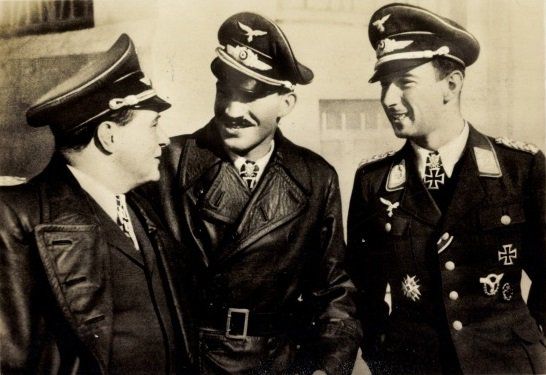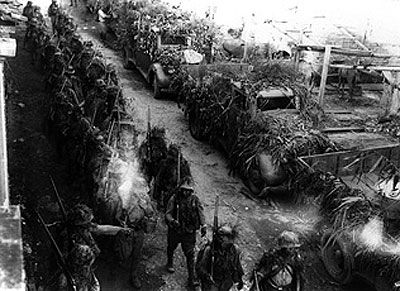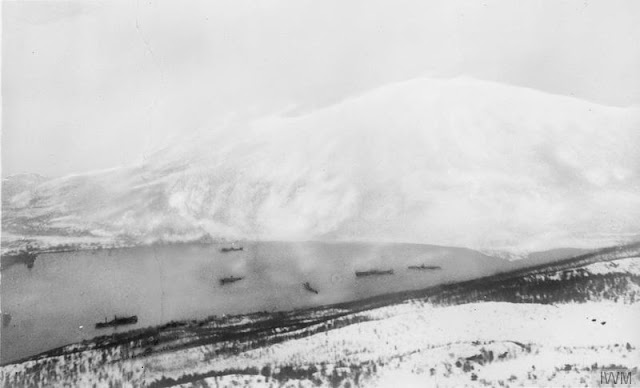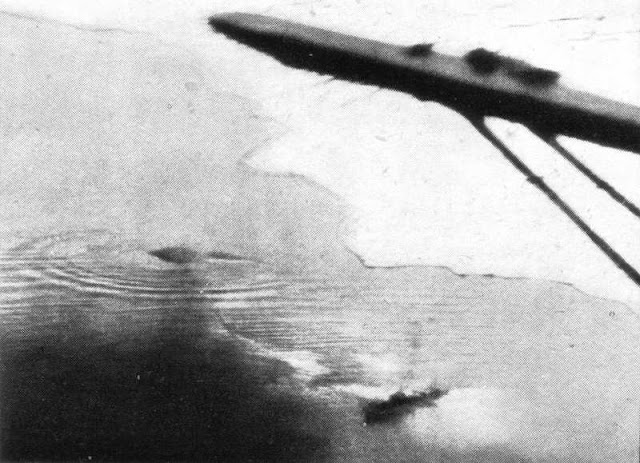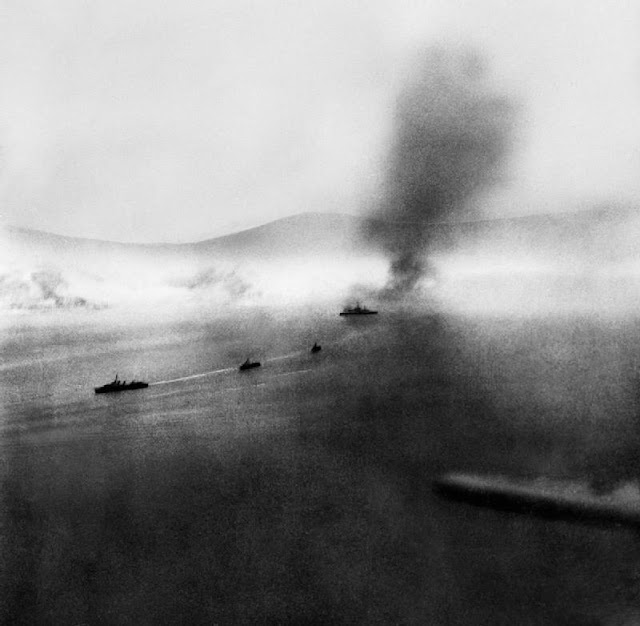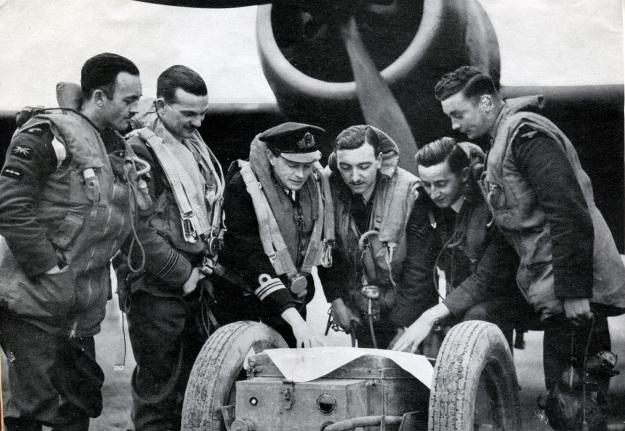Monday 30 June 1941
 |
| A Soviet soldier of the 136th Infantry Regiment, 14th Infantry Division captured by German mountain troops near Murmansk. |
Eastern Front: On 30 June 1941, Operation Barbarossa is fulfilling all of Adolf Hitler's dreams of conquest. His troops have advanced deep into Russia at a cost of only 8,886 men killed. By comparison, Soviet losses at Brest Fortress alone have numbered about 2000 dead and 6800 men captured. Still, the Wehrmacht is spoiled from all of its previous cheap successes (excepting Crete) and not used to such high numbers of casualties, so OKW demands detailed reports on losses from the different Army Groups (which is why we have such precise figures).
These successes bring the Mölders (shown below) victory count to 82 planes, besting the 80 victories of Rittmeister Manfred Freiherr von Richthofen (shown above) during World War I (Wolfram Freiherr von Richthofen, the Red Baron's fourth cousin, is a top Luftwaffe general during World War II and Manfred was a colleague of Hermann Goering, so the name carries both legendary and current weight in 1941). The Red Baron's World War I victory total was one of the most respected during the inter-war years, so besting it has been an objective for every top Luftwaffe fighter pilot.
Both in the air and on the ground, the war is advancing east in a hurry. People in Moscow have been skittish since the first day of the campaign, and tensions are rising. There is an air raid alert in Moscow today, but it turns out to be a false alarm.
In the Far North sector, Operation Silver Fox continues toward Murmansk without achieving any breakthroughs. The German troops, in particular, begin to slow as they lose the element of surprise. General Dietl's 2nd Mountain Division troops are unable to penetrate the base of the Rybachy peninsula, while the main advance a little further south toward the Litsa River makes little progress.
In addition, the Finnish 2nd Division makes a small attack in central Karelia. Its goal is to prepare for a larger offensive during July. Finnish 2nd Division (Colonel Blick) makes good progress toward its objective of capturing the area between lakes Pyhäjärvi and Tyrjänjärvi. Being familiar with the climate and terrain, the Finns have none of the problems experienced by the German troops further north.
In the Army Group Center sector, Field Marshal von Bock's panzers probe east of East. In a daring raid, the 4th Panzer Division seizes a railroad bridge at Svisloch. This cuts off parts of the Soviet 4th Airborne Corps and 20th Mechanized Corps. The main action, however, is many miles to the rear, where German Fourth and Ninth Armies are reducing the Soviet 10th Army and other forces near Bialystok. The German 45th Infantry Division, fresh from its victory at Brest-Litovsk, receives orders to head east along with the rest of the Wehrmacht - no time to waste on celebrations.
General Heinz Guderian, supported "by back channels" by OKH chief Franz Halder, ignores Hitler's stop order and continues barrelling east toward Bobruisk. This full-scale advance by 2nd Panzer Group he euphemistically characterizes as a "reconnaissance in force." Guderian also boards an observation plane and flies over the Minsk-Bialystok pocket. He decides from his personal observation that his panzers are not needed there because General Hoth's 3rd Panzer Group has the situation in hand.
In the Army Group South sector, the Stavka gives up on the Battle of Brody. While it has bought the Soviets some time, the disjointed attacks by large Soviet armored forces against Field Marshal von Rundstedt's spearhead have cost the Soviets hundreds, if not thousands, of tank losses. The surviving Soviet units of the Southwestern Front are directed to retreat to the Stalin Line in order to defend the approaches to Kyiv. General Popel remains trapped in Dubno with his remaining tanks but prepares to break out to the east in accordance with the Stavka's orders.
This concludes the Battle of Brody, a decisive German victory. German troops of 1st Panzer Group (Ewald von Kleist) continue advancing toward Kyiv and take Lviv. The Hungarian Carpathian Group makes its first attack of the war to clear passes through the Carpathian Mountains. The retreating Soviets adopt a scorched-earth strategy, mining roads and blowing up bridges, but otherwise, the Hungarians face minimal resistance.
Syrian/Lebanon Campaign: The Australian 21st Brigade claims the ridge overlooking the Damour River Valley. This ridge controls the valley, a key defensive position between Damascus and Beirut. North of Beirut, the Vichy French launch a counterattack at Nebek which makes some small gains but then retreats after fierce defense by the defending Free French 2nd Battalion.
European Air Operations: During the day, RAF Fighter Command sends a circus mission to attack the power stations at Pont-au-Vendin.
RAF Bomber Command mounts daylight raids against Bremen and Kiel. The Kiel raid includes the first use during daylight hours of the Handley Page Halifax bombers (first used during a night raid on Le Havre on 10-11 March), whose existence is not even publically acknowledged yet by the Air Ministry.
Night fighter ace Egmont Prinz zur Lippe-Weißenfeld collides with another Bf 110 night fighter piloted by Rudolf Schoenert during training. Both pilots survive.
Battle of the Baltic: Soviet freighter Krimulda hits a mine and sinks. Five men perish.
Soviet patrol boat MO-143 hits a mine and sinks off Mhni.
Battle of the Atlantic: U-66 (Kptlt. Richard Zapp), on its second patrol out of Lorient, is operating a few hundred miles west of the Canary Islands and tracking Convoy SL-78. Following upon two sinkings on the 29th, U-66 adds to its victims today by torpedoing and sinking 5614-ton British freighter Saint Aslem. There are 34 deaths and 33 survivors.
Royal Navy light cruiser HMS Dunedin stops and captures 4993-ton Vichy French freighter Ville De Tamatave east of St. Paul.
Convoy OB-341 departs from Liverpool, Convoy HX-136 departs from Halifax, Convoy WS 9B (Winston Special) departs the Clyde bound for Suez and Bombay.
Royal Navy anti-aircraft cruiser HMS Euryalus (Captain Eric W. Bush) is commissioned.
Canadian corvette HMCS Camrose (Lt. Louis R. Pavillard) and minesweeper Wasaga (Lt. John B. Raine) are commissioned, while minesweeper Twois Rivieres is launched in Quebec.
US Navy submarine USS Grayback (Lt. Willard A. Saunders) is commissioned, and heavy cruiser Boston and destroyers Hobby and Kalk are laid down.
For the month of June 1941, the Allies lose in the Atlantic:
The Kriegsmarine, meanwhile, loses four U-boats and the Italians one submarine, still a very low number relative to the damage they are causing. The Axis loses 17 ships of 58,425 tons in the Mediterranean, mostly Italian.
Battle of the Mediterranean: The latest mission to deliver aircraft to Malta, Operation Railway 2, goes disastrously wrong when a Hurricane taking off from HMS Furious hits the bridge of the carrier on takeoff. This starts a fire that kills three officers, injures five Hurricane pilots waiting to take off, and damages all five of their planes. Only nine Hurricanes arrive from Furious and twelve from the accompanying carrier, Ark Royal.
Dutch submarine O-23 torpedoes and sinks 5371-ton Italian freighter Capacitas south of Livorno in the Ligurian Sea (about 11 km off San Vicenzo).
Royal Navy submarine HMS Torbay surfaces and sinks a caique off Cape Malea.
The Luftwaffe (Junkers Ju 87 aircraft of I Staffeln, Sturzkampfgeschwader 2) attacks a Tobruk supply convoy, damaging sloop Flamingo and gunboat Cricket. The Flamingo has to tow Cricket back to Alexandria. Once there, however, Cricket is judged to be a total loss, though it is used for some time as a stationary anti-aircraft platform.
An Italian convoy of six freighters/transports departs Naples bound for Tripoli.
Italian special operations submarine Scirè launches midget submarines to infiltrate Malta's Grand Harbour, but they score no successes.
Battle of the Black Sea: The Soviets begin to evacuate Odesa. They scuttle freighters Orel, Peter the Great, Plekhanov, Pskov, and Voikov.
Propaganda: The Soviet Information Bureau releases a communique:
Applied Science: Two copies of Frank Whittle's advanced W-1 jet engine have arrived in the United States aboard a B-17 pursuant to General Hap Arnold's request. Impressed, he tasks the US Army Air Force to develop an engine based upon it. However, the first order issued today, a $483,600 joint Army-Navy contract, visualizes a turbojet, not a pure jet engine. While it may appear comforting for aviators of the day to see a propeller on the engine, in fact, a turbojet is a much more difficult project than simply a jet engine.
Vichy French/Soviet Relations: Premier Petain's government breaks diplomatic relations with the Soviet Union.
German/Soviet Relations: At some point during this week - details are very sketchy - Soviet Premier Joseph Stalin attempts to broker a peace deal with Hitler through a Bulgarian diplomat, Ivan Stamenov. Foreign Minister Molotov has Lavrentiy Beria arrange this by using one of Beria's subordinates, NKVD officer Pavel Sudoplatov, who has a "casual" lunch at a Moscow restaurant with the diplomat. Sudoplatov explains to Stamenov what to say to Hitler. Stalin is willing to offer huge concessions for peace, including Ukraine and all of the areas granted to him in the "secret protocol" to the 23 August 1939 Molotov/Ribbentrop Pact in the Baltic States. Stalin does, though, demand to know why Hitler invaded the USSR.
Hitler turns Stalin down flat and will not even consider the offer. This is one of Hitler's biggest mistakes. These revelations were hidden for many years but came to light during the period after Stalin died from natural causes in the 1950s. There are few other details of this little-known incident, but there is no reason to doubt that it happened. This peace offer was classified as treason and was one of the charges used to condemn Beria to death. The others involved - including the Bulgarian Stamenov diplomat used as the go-between - submitted affidavits confirming the incident. Sudoplatov confessed to it under interrogation and also was convicted of treason, serving 15 full years in prison (yes, there are many questions about the validity of such "proof," but there was a lot of corroboration). Molotov was never tried for treason despite his deep role in the incident, but gradually fell out of favor, lost his positions one by one, and by 1962 was a "non-person" in the Soviet bureaucracy.
German/Swedish Relations: The German 163rd Infantry Division (General of Artillery Engelbrecht) completes its transfer by rail from Narvik to Helsinki. This includes a controversial passage on the train through northern Sweden. The Wehrmacht troops pass through quietly in blacked-out cars and with their weapons in separate cars.
German/Italian Relations: Hitler accepts Mussolini's offer to send an expeditionary force to the Eastern Front. It will be composed of three divisions at first.
Soviet/Ukrainian Relations: The Organization of Ukrainian Nationalists announces the Declaration of the Ukrainian State Act and declares the Ukrainian National Government under the leadership of Iaroslav Stetsko. According to Willem Pruller's "Diary of a German Soldier" (published after the war), Ukrainians warmly greet advancing German troops, with women giving them food and bouquets of flowers. Many Ukrainians see the Wehrmacht as liberators from the evils of communism.
Soviet Military: For the second time during the young war Soviet Premier Joseph Stalin reorganizes his leadership team. This time, he creates the State Defense Committee (Gosudarstvennyj Komitet Oborony, GKO). As opposed to the Stavka, which he formed just after the start of the war and is of purely military composition (at least among its permanent members), the GKO includes G.M. Malenkov, the party personnel chief and member of the Central Committee, and NKVD boss Lavrentia Beria. The other members are General Voroshilov and Foreign Minister Molotov. The addition of leaders of the Party who have no military experience is an early indication that Stalin views the fight against Hitler as being as much political as military. The greatest need, for now, is to keep the men fighting against hopeless odds and ruthlessly control the rear areas. Stalin apparently chooses the GKO's members as much for his personal relationship with them as their "other" jobs, as they are all old cronies who can be relied upon to the end.
The GKO is the apex of the Soviet government during World War II. It controls all aspects of both military and civilian life, and everyone in the Soviet Union ultimately answers to it. In practice, the GKO delegates much of its military authority to the Stavka and concerns itself with organizing the homefront.
British Military: Prime Minister Winston Churchill sends a memo to the new Minister of Supply Lord Beaverbrook in which he notes that "the question of a much heavier tank has now come sharply to the front." This is because he has received reports from the eastern front about the Soviet KV tank, "a very large tank, said to be over 70 tons, against which the German A/T 6-pounder [Panzer IV] has proved useless."
Dutch Military: The Dutch government-in-exile still controls extensive possessions in the South Pacific, and it has the resources to defend them if necessary. Today, the Netherlands Purchasing Commission, acting on behalf of the Dutch government in exile in London, signs contract 71311/NA with North American Aviation. This cash deal calls for delivery to the Dutch of 162 B-25C bombers (designated NA-90). Delivery is to made to the Dutch East Indies once the USAAF has received its own initial orders of roughly 1000 B-25s - which is not projected to take place until November 1942.
US Military: The United States Navy orders two Grumman XF6F-1 Hellcat prototypes, BuNos 02981 and 02982. This plane is intended as a successor to the F4F Wildcat.
An accounting shows that, as of this date, the USN has 1899 ships and smaller craft and a ration strength of 338,786. This includes 284,427 sailors, 54,359 Marines, and 19,235 members of the Coast Guard.
Holocaust: The last trains leave Jassy (Iasi) carrying Romanian Jews. The two trains head for Calarasi and Podul Iloaiei, respectively. Many people die on the journey, and many others later.
American Homefront: Secretary of the Navy Frank Knox gives a dinner speech at the Bethlehem Shipbuilding Company in Fore River, Massachusetts. He emphasizes the importance of patrolling the seas so that the US industrial might can deliver weapons of war to make the German people "understand the cruelty and ruthlessness which Hitler has unloosed upon the world."
President Franklin Roosevelt dedicates his presidential library in Hyde Park, New York.
June 1941
June 1, 1941: Farhud Pogrom
June 2, 1941: Massacres on Crete
June 3, 1941: Kandanos Massacre
June 4, 1941: Kaiser Wilhelm Passes Away
June 5, 1941: Death in Chungking
June 6, 1941: Hitler's Commissar Order
June 7, 1941: Commandos Strike at Pessac
June 8, 1941: British Invade Syria and Lebanon
June 9, 1941: Litani River Battle
June 10, 1941: British Take Assab
June 11, 1941: Hitler Thinking Beyond Russia
June 12, 1941: St. James Agreement
June 13, 1941: Lützow Damaged
June 14, 1941: Latvian June Deportations
June 15, 1941: Operation Battleaxe
June 16, 1941: The Old Lion
June 17, 1941: British Spanked in North Africa
June 18, 1941: Turkey Turns Its Back
June 19, 1941: Cheerios Introduced
June 20, 1941: Birth of US Army Air Force
June 21, 1941: Damascus Falls
June 22, 1941: Germany Invades Russia
June 23, 1941: A Soviet KV Tank Causes Havoc
June 24, 1941: Kaunas and Vilnius Fall
June 25, 1941: Finland Declares War
June 26, 1941: Bombing of Kassa
June 27, 1941: Encirclement At Minsk
June 28, 1941: Minsk Falls
June 29, 1941: Brest Fortress Falls
June 30, 1941: Mölders Becomes Top Ace
July 1941
July 1, 1941: US TV Broadcasting Starts
July 2, 1941: MAUD Report
July 3, 1941: Stalin Speaks
July 4, 1941: Pogroms in Eastern Europe
July 5, 1941: Germans on Schedule
July 6, 1941: Australians Attack Damour
July 7, 1941: US Marines in Iceland
July 8, 1941: Flying Fortresses In Action
July 9, 1941: British Take Damour
July 10, 1941: Sword and Scabbard Order
July 11, 1941: Cease-fire in Syria and Lebanon
July 12, 1941: Anglo/Russian Assistance Pact
July 13, 1941: Uprising in Montenegro
July 14, 1941: Katyusha Rocket Launchers in Action
July 15, 1941: Smolensk Falls
July 16, 1941: Stalin's Son Captured
July 17, 1941: Heydrich Orders Mass Executions
July 18, 1941: Twin Pimples Raid
July 19, 1941: V for Victory
July 20, 1941: The Man Who Wouldn't Shoot
July 21, 1941: Moscow in Flames
July 22, 1941: Soviet Generals Executed
July 23, 1941: Secret Plan JB 355
July 24, 1941: Operation Sunrise
July 25, 1941: US Naval Alert
July 26, 1941: Italian E-Boat Attack on Malta
July 27, 1941: MacArthur Returns
July 28, 1941: Auschwitz Exterminations
July 29, 1941: Rescue From Crete
July 30, 1941: Raid on Petsamo and Kirkenes
July 31, 1941: Final Solution Order
2020
 |
 |
 |
 |
|
|
 |
 |
 |
| Werner Mölders in a propaganda film. |
In the Far North sector, Operation Silver Fox continues toward Murmansk without achieving any breakthroughs. The German troops, in particular, begin to slow as they lose the element of surprise. General Dietl's 2nd Mountain Division troops are unable to penetrate the base of the Rybachy peninsula, while the main advance a little further south toward the Litsa River makes little progress.
In addition, the Finnish 2nd Division makes a small attack in central Karelia. Its goal is to prepare for a larger offensive during July. Finnish 2nd Division (Colonel Blick) makes good progress toward its objective of capturing the area between lakes Pyhäjärvi and Tyrjänjärvi. Being familiar with the climate and terrain, the Finns have none of the problems experienced by the German troops further north.
In the Army Group Center sector, Field Marshal von Bock's panzers probe east of East. In a daring raid, the 4th Panzer Division seizes a railroad bridge at Svisloch. This cuts off parts of the Soviet 4th Airborne Corps and 20th Mechanized Corps. The main action, however, is many miles to the rear, where German Fourth and Ninth Armies are reducing the Soviet 10th Army and other forces near Bialystok. The German 45th Infantry Division, fresh from its victory at Brest-Litovsk, receives orders to head east along with the rest of the Wehrmacht - no time to waste on celebrations.
General Heinz Guderian, supported "by back channels" by OKH chief Franz Halder, ignores Hitler's stop order and continues barrelling east toward Bobruisk. This full-scale advance by 2nd Panzer Group he euphemistically characterizes as a "reconnaissance in force." Guderian also boards an observation plane and flies over the Minsk-Bialystok pocket. He decides from his personal observation that his panzers are not needed there because General Hoth's 3rd Panzer Group has the situation in hand.
In the Army Group South sector, the Stavka gives up on the Battle of Brody. While it has bought the Soviets some time, the disjointed attacks by large Soviet armored forces against Field Marshal von Rundstedt's spearhead have cost the Soviets hundreds, if not thousands, of tank losses. The surviving Soviet units of the Southwestern Front are directed to retreat to the Stalin Line in order to defend the approaches to Kyiv. General Popel remains trapped in Dubno with his remaining tanks but prepares to break out to the east in accordance with the Stavka's orders.
This concludes the Battle of Brody, a decisive German victory. German troops of 1st Panzer Group (Ewald von Kleist) continue advancing toward Kyiv and take Lviv. The Hungarian Carpathian Group makes its first attack of the war to clear passes through the Carpathian Mountains. The retreating Soviets adopt a scorched-earth strategy, mining roads and blowing up bridges, but otherwise, the Hungarians face minimal resistance.
 |
| German soldiers near Murmansk prepare to execute two captured Soviet soldiers. |
European Air Operations: During the day, RAF Fighter Command sends a circus mission to attack the power stations at Pont-au-Vendin.
RAF Bomber Command mounts daylight raids against Bremen and Kiel. The Kiel raid includes the first use during daylight hours of the Handley Page Halifax bombers (first used during a night raid on Le Havre on 10-11 March), whose existence is not even publically acknowledged yet by the Air Ministry.
Night fighter ace Egmont Prinz zur Lippe-Weißenfeld collides with another Bf 110 night fighter piloted by Rudolf Schoenert during training. Both pilots survive.
Battle of the Baltic: Soviet freighter Krimulda hits a mine and sinks. Five men perish.
Soviet patrol boat MO-143 hits a mine and sinks off Mhni.
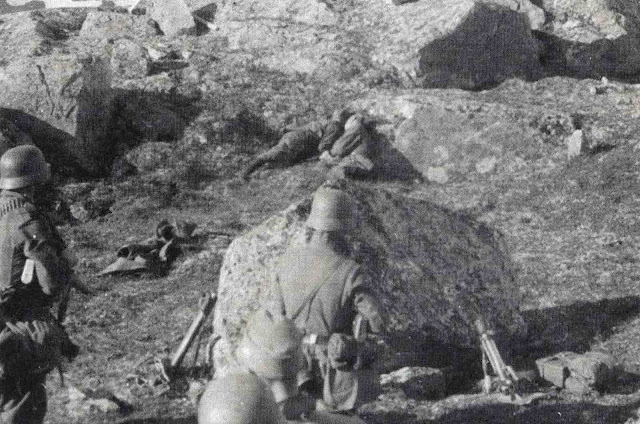 |
| German mountain troops have just shot two Soviet prisoners. Their remains lay undisturbed near this spot, open to the elements until rediscovered in 2013. |
Royal Navy light cruiser HMS Dunedin stops and captures 4993-ton Vichy French freighter Ville De Tamatave east of St. Paul.
Convoy OB-341 departs from Liverpool, Convoy HX-136 departs from Halifax, Convoy WS 9B (Winston Special) departs the Clyde bound for Suez and Bombay.
Royal Navy anti-aircraft cruiser HMS Euryalus (Captain Eric W. Bush) is commissioned.
Canadian corvette HMCS Camrose (Lt. Louis R. Pavillard) and minesweeper Wasaga (Lt. John B. Raine) are commissioned, while minesweeper Twois Rivieres is launched in Quebec.
US Navy submarine USS Grayback (Lt. Willard A. Saunders) is commissioned, and heavy cruiser Boston and destroyers Hobby and Kalk are laid down.
For the month of June 1941, the Allies lose in the Atlantic:
- 104 ships
- 415,255 tons of shipping
The Kriegsmarine, meanwhile, loses four U-boats and the Italians one submarine, still a very low number relative to the damage they are causing. The Axis loses 17 ships of 58,425 tons in the Mediterranean, mostly Italian.
 |
| Finnish troops in the border town of Tuulos, Eastern Karelia, team up with the Germans on 30 June 1941. Note the captured Soviet light tank T-26 with added Finnish markings. |
Dutch submarine O-23 torpedoes and sinks 5371-ton Italian freighter Capacitas south of Livorno in the Ligurian Sea (about 11 km off San Vicenzo).
Royal Navy submarine HMS Torbay surfaces and sinks a caique off Cape Malea.
The Luftwaffe (Junkers Ju 87 aircraft of I Staffeln, Sturzkampfgeschwader 2) attacks a Tobruk supply convoy, damaging sloop Flamingo and gunboat Cricket. The Flamingo has to tow Cricket back to Alexandria. Once there, however, Cricket is judged to be a total loss, though it is used for some time as a stationary anti-aircraft platform.
An Italian convoy of six freighters/transports departs Naples bound for Tripoli.
Italian special operations submarine Scirè launches midget submarines to infiltrate Malta's Grand Harbour, but they score no successes.
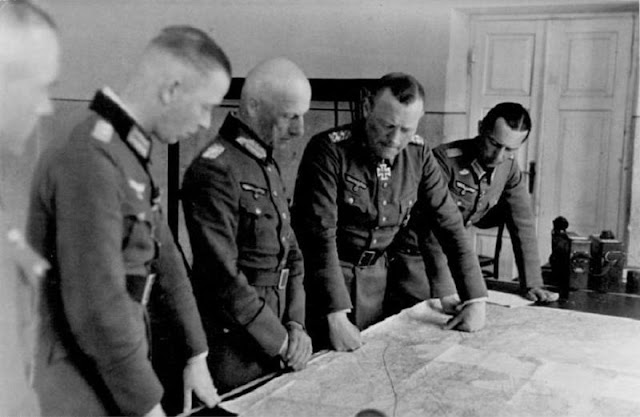 |
| Left to right: Oberstleutnant Sigurd-Horstmar Freiherr von Beaulieu-Marconnay, Generalfeldmarschall Wilhelm Ritter von Leeb (commander of Army Group North), Generaloberst Erich Hoepner, Oberst Günther Angern, 30 June 1941 (Federal Archives, Bild 146-1971-068-14). |
Propaganda: The Soviet Information Bureau releases a communique:
Fighting is continuing against strong enemy motorized forces in the Lutsk area. Despite his fresh armored reinforcements, all the enemy's attempt to break through our lines in the direction of Novograd Volynskiy [Ukraine] and Shepetovka have failed and been beaten back. Our armored forces and the Soviet air force even succeeded in destroying a great part of the enemy armored and motorized troops.In fact, the panzers already are in Lutsk, while the German attempts to "break through our lines" have all succeeded to date.
Applied Science: Two copies of Frank Whittle's advanced W-1 jet engine have arrived in the United States aboard a B-17 pursuant to General Hap Arnold's request. Impressed, he tasks the US Army Air Force to develop an engine based upon it. However, the first order issued today, a $483,600 joint Army-Navy contract, visualizes a turbojet, not a pure jet engine. While it may appear comforting for aviators of the day to see a propeller on the engine, in fact, a turbojet is a much more difficult project than simply a jet engine.
 |
| Original caption: "The Reds' withdrawal route after the great enclosure battle is sown with rubble and vehicle remains of all kinds. Our Stukas put their bombs right next to the road." (Lessmann, Federal Archives, Bild 101I-006-2202-30). |
German/Soviet Relations: At some point during this week - details are very sketchy - Soviet Premier Joseph Stalin attempts to broker a peace deal with Hitler through a Bulgarian diplomat, Ivan Stamenov. Foreign Minister Molotov has Lavrentiy Beria arrange this by using one of Beria's subordinates, NKVD officer Pavel Sudoplatov, who has a "casual" lunch at a Moscow restaurant with the diplomat. Sudoplatov explains to Stamenov what to say to Hitler. Stalin is willing to offer huge concessions for peace, including Ukraine and all of the areas granted to him in the "secret protocol" to the 23 August 1939 Molotov/Ribbentrop Pact in the Baltic States. Stalin does, though, demand to know why Hitler invaded the USSR.
Hitler turns Stalin down flat and will not even consider the offer. This is one of Hitler's biggest mistakes. These revelations were hidden for many years but came to light during the period after Stalin died from natural causes in the 1950s. There are few other details of this little-known incident, but there is no reason to doubt that it happened. This peace offer was classified as treason and was one of the charges used to condemn Beria to death. The others involved - including the Bulgarian Stamenov diplomat used as the go-between - submitted affidavits confirming the incident. Sudoplatov confessed to it under interrogation and also was convicted of treason, serving 15 full years in prison (yes, there are many questions about the validity of such "proof," but there was a lot of corroboration). Molotov was never tried for treason despite his deep role in the incident, but gradually fell out of favor, lost his positions one by one, and by 1962 was a "non-person" in the Soviet bureaucracy.
German/Swedish Relations: The German 163rd Infantry Division (General of Artillery Engelbrecht) completes its transfer by rail from Narvik to Helsinki. This includes a controversial passage on the train through northern Sweden. The Wehrmacht troops pass through quietly in blacked-out cars and with their weapons in separate cars.
German/Italian Relations: Hitler accepts Mussolini's offer to send an expeditionary force to the Eastern Front. It will be composed of three divisions at first.
Soviet/Ukrainian Relations: The Organization of Ukrainian Nationalists announces the Declaration of the Ukrainian State Act and declares the Ukrainian National Government under the leadership of Iaroslav Stetsko. According to Willem Pruller's "Diary of a German Soldier" (published after the war), Ukrainians warmly greet advancing German troops, with women giving them food and bouquets of flowers. Many Ukrainians see the Wehrmacht as liberators from the evils of communism.
 |
| New pumps just installed at Camp Polk, Louisiana, 30 June 1941 (The National WWII Museum). |
The GKO is the apex of the Soviet government during World War II. It controls all aspects of both military and civilian life, and everyone in the Soviet Union ultimately answers to it. In practice, the GKO delegates much of its military authority to the Stavka and concerns itself with organizing the homefront.
British Military: Prime Minister Winston Churchill sends a memo to the new Minister of Supply Lord Beaverbrook in which he notes that "the question of a much heavier tank has now come sharply to the front." This is because he has received reports from the eastern front about the Soviet KV tank, "a very large tank, said to be over 70 tons, against which the German A/T 6-pounder [Panzer IV] has proved useless."
Dutch Military: The Dutch government-in-exile still controls extensive possessions in the South Pacific, and it has the resources to defend them if necessary. Today, the Netherlands Purchasing Commission, acting on behalf of the Dutch government in exile in London, signs contract 71311/NA with North American Aviation. This cash deal calls for delivery to the Dutch of 162 B-25C bombers (designated NA-90). Delivery is to made to the Dutch East Indies once the USAAF has received its own initial orders of roughly 1000 B-25s - which is not projected to take place until November 1942.
 |
| Mare Island Navy Yard, Vallejo, California on 30 June 1941. The ship under construction at the left is the USS Wahoo. |
An accounting shows that, as of this date, the USN has 1899 ships and smaller craft and a ration strength of 338,786. This includes 284,427 sailors, 54,359 Marines, and 19,235 members of the Coast Guard.
Holocaust: The last trains leave Jassy (Iasi) carrying Romanian Jews. The two trains head for Calarasi and Podul Iloaiei, respectively. Many people die on the journey, and many others later.
American Homefront: Secretary of the Navy Frank Knox gives a dinner speech at the Bethlehem Shipbuilding Company in Fore River, Massachusetts. He emphasizes the importance of patrolling the seas so that the US industrial might can deliver weapons of war to make the German people "understand the cruelty and ruthlessness which Hitler has unloosed upon the world."
President Franklin Roosevelt dedicates his presidential library in Hyde Park, New York.
 |
| President Roosevelt at the opening of his library in Hyde Park, June 30, 1941. |
June 1941
June 1, 1941: Farhud Pogrom
June 2, 1941: Massacres on Crete
June 3, 1941: Kandanos Massacre
June 4, 1941: Kaiser Wilhelm Passes Away
June 5, 1941: Death in Chungking
June 6, 1941: Hitler's Commissar Order
June 7, 1941: Commandos Strike at Pessac
June 8, 1941: British Invade Syria and Lebanon
June 9, 1941: Litani River Battle
June 10, 1941: British Take Assab
June 11, 1941: Hitler Thinking Beyond Russia
June 12, 1941: St. James Agreement
June 13, 1941: Lützow Damaged
June 14, 1941: Latvian June Deportations
June 15, 1941: Operation Battleaxe
June 16, 1941: The Old Lion
June 17, 1941: British Spanked in North Africa
June 18, 1941: Turkey Turns Its Back
June 19, 1941: Cheerios Introduced
June 20, 1941: Birth of US Army Air Force
June 21, 1941: Damascus Falls
June 22, 1941: Germany Invades Russia
June 23, 1941: A Soviet KV Tank Causes Havoc
June 24, 1941: Kaunas and Vilnius Fall
June 25, 1941: Finland Declares War
June 26, 1941: Bombing of Kassa
June 27, 1941: Encirclement At Minsk
June 28, 1941: Minsk Falls
June 29, 1941: Brest Fortress Falls
June 30, 1941: Mölders Becomes Top Ace
July 1941
July 1, 1941: US TV Broadcasting Starts
July 2, 1941: MAUD Report
July 3, 1941: Stalin Speaks
July 4, 1941: Pogroms in Eastern Europe
July 5, 1941: Germans on Schedule
July 6, 1941: Australians Attack Damour
July 7, 1941: US Marines in Iceland
July 8, 1941: Flying Fortresses In Action
July 9, 1941: British Take Damour
July 10, 1941: Sword and Scabbard Order
July 11, 1941: Cease-fire in Syria and Lebanon
July 12, 1941: Anglo/Russian Assistance Pact
July 13, 1941: Uprising in Montenegro
July 14, 1941: Katyusha Rocket Launchers in Action
July 15, 1941: Smolensk Falls
July 16, 1941: Stalin's Son Captured
July 17, 1941: Heydrich Orders Mass Executions
July 18, 1941: Twin Pimples Raid
July 19, 1941: V for Victory
July 20, 1941: The Man Who Wouldn't Shoot
July 21, 1941: Moscow in Flames
July 22, 1941: Soviet Generals Executed
July 23, 1941: Secret Plan JB 355
July 24, 1941: Operation Sunrise
July 25, 1941: US Naval Alert
July 26, 1941: Italian E-Boat Attack on Malta
July 27, 1941: MacArthur Returns
July 28, 1941: Auschwitz Exterminations
July 29, 1941: Rescue From Crete
July 30, 1941: Raid on Petsamo and Kirkenes
July 31, 1941: Final Solution Order
2020
